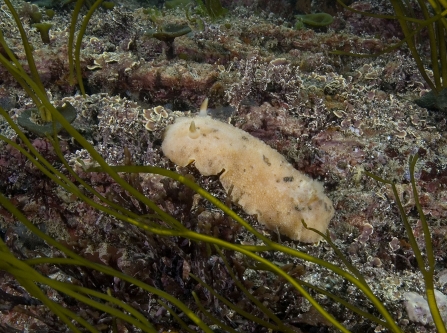It's no secret that marine species often have fantastic names - phosphorescent sea pen or solar-powered sea slug, anyone? But there are some with nicknames, or even official names, that suggest they might have been discovered just before lunchtime. Read on for a taster of the delicious-sounding animals in our waters.
Grub's Up: Marine Life with Tasty Names
Breadcrumb sponge Halichondria panicea © Minette Layne

Baked bean sea squirts © Lara Howe
Fry up
Getting the day off to a good start is the breadcrumb sponge, named for its roughly textured surface. It comes in so many different shapes and colours that for a long time it was thought to be more than one species! One way to identify it is by its strong smell of burnt gunpowder, which it uses to deter predators.
Ascidians get their common name, sea squirts, from their habit of shooting out water when removed from the sea. The reddish-brown colour and dense clusters of the baked bean ascidian led to its doubly inventive name. Its shape can range from squat and round to tall and long, depending on how close its neighbours are.
The sandalled anemone can be entirely white or grey, but is most striking in its so-called 'fried egg' variation. This species reproduces by splitting itself in two, with each half then growing into a whole new anemone. On the shore look for it in shady areas like rock walls and overhangs.

Sea lemon slug © Paul Naylor
Five a day
For a twist of citrus look no further than the sea lemon - a sea slug named for its yellow hue (though individuals can be green, brown, pink, or white too). This species usually prefers deeper water, but has been known to hang out in rockpools. Even in muted shades they're hard to miss, as they can grow to 12 cm long!
Sea lettuce, a type of seaweed, is a familiar sight on our coasts. Its distinctive fronds have a vibrant green colour but are only two cells thick, giving them a translucent appearance. Much like its salad namesake this seaweed is edible, and can be found in many in Japanese and Korean recipes.
If you've ever chanced upon a cluster of cuttlefish eggs you'll know why they have the nickname 'sea grapes'. Their dark colour comes from the mum's ink, but when held up to the light they reveal the young inside. If you come across any on our coasts pop them back in the sea and they may still hatch.

Cuttlefish eggs © Alexander Mustard/2020VISION
Snack time
Despite sometimes being called ross coral, Pentapora foliacea is really a colonial animal called a bryozoan. Examine the wavy folds that earned it the nickname 'potato crisp' and you'll see a mesh of little boxes. These compartments house tiny animals called zooids, each with a different function within the colony.
Raspailia ramosa is dark brown and grows in long branching sections - as such it's often called the 'chocolate finger sponge'. Despite its distinctive looks this species can be hard to spot, thanks to its coat of bristly hairs. These allow it to snag particles of food from the water, but can also attract a thick, silty covering.
Axinella infundibuliformis is a bit of a tongue-twister, so you can't blame people for saying 'prawn cracker sponge' instead. This species grows in a curved shape, eventually forming a cup up to 10 cm in diameter. Its foam-like texture is due to lots of little pores called ostia (which draw water in) and oscules (which let water out).
Keeping our seas special
The species in our seas are truly amazing, but they need your help to stay that way. Why not volunteer with us as a Marine Champion or make small but significant lifestyle changes with a Wilder Solent pledge?

